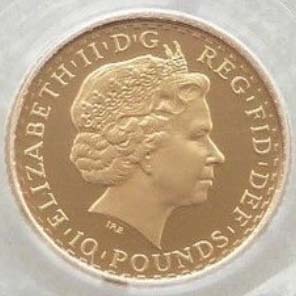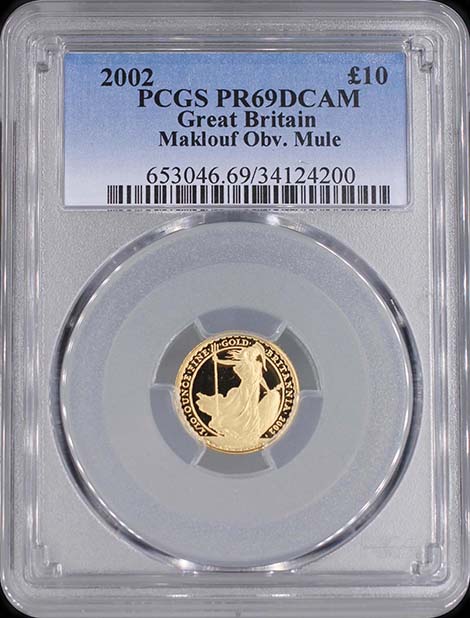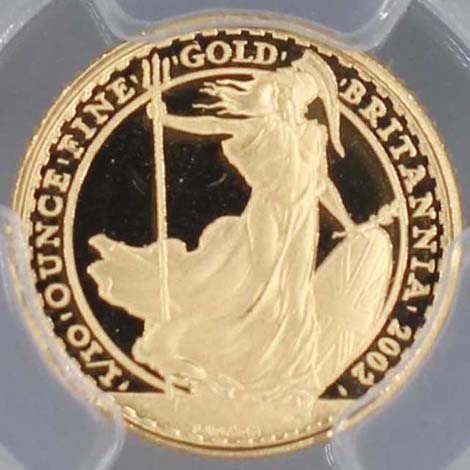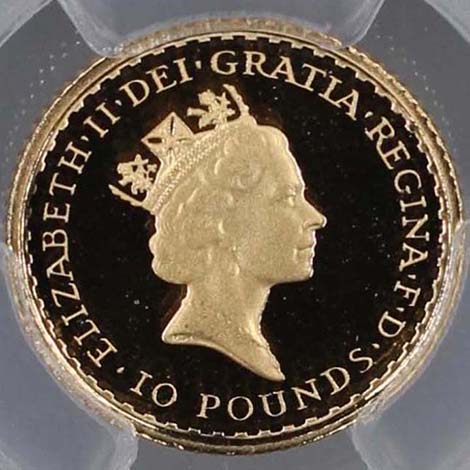 There are only 3 known authenticated and certified obverse mules on the Britannia Proof Gold Coin Series from Great Britain. In 1987, the Royal Mint introduced the gold Britannia coins as bullion coins in mint state and in proof for collectors.
They were issued in 1 oz, 1/2 oz, 1/4 oz, and 1/10 oz sizes with face values in British Pounds of 100, 50, 25 and 10. They are .917 fine gold (22 carat) and are legal tender in Great Britain. Raphael Maklouf was the sculptor who designed the royal portrait of Queen Elizabeth.
There are only 3 known authenticated and certified obverse mules on the Britannia Proof Gold Coin Series from Great Britain. In 1987, the Royal Mint introduced the gold Britannia coins as bullion coins in mint state and in proof for collectors.
They were issued in 1 oz, 1/2 oz, 1/4 oz, and 1/10 oz sizes with face values in British Pounds of 100, 50, 25 and 10. They are .917 fine gold (22 carat) and are legal tender in Great Britain. Raphael Maklouf was the sculptor who designed the royal portrait of Queen Elizabeth.
 There have been 5 different portraits used on Great Britain's coinage of Queen Elizabeth during her reign. The gold Britannias that were issued from 1987 through 1997 feature the 3rd portrait of Queen Elizabeth on the obverse, with the Britannia image on the reverse. The 4th portrait in 1998 to 2015 presented a more mature depiction of Queen Elizabeth.
There have been 5 different portraits used on Great Britain's coinage of Queen Elizabeth during her reign. The gold Britannias that were issued from 1987 through 1997 feature the 3rd portrait of Queen Elizabeth on the obverse, with the Britannia image on the reverse. The 4th portrait in 1998 to 2015 presented a more mature depiction of Queen Elizabeth.
 This amazing mint error occurred when the obverse die of Queen Elizabeth's 3rd portrait (used to strike the gold Britannias from 1987 through 1997) was accidentally paired with the Britannia reverse die, instead of the correct and updated die depicting Queen Elizabeth's 4th portrait (used from 1998 to 2015). This created a mule consisting of wrong paired dies.
This amazing mint error occurred when the obverse die of Queen Elizabeth's 3rd portrait (used to strike the gold Britannias from 1987 through 1997) was accidentally paired with the Britannia reverse die, instead of the correct and updated die depicting Queen Elizabeth's 4th portrait (used from 1998 to 2015). This created a mule consisting of wrong paired dies.
 The 4th portrait was issued from 1998 to 2015, designed by Ian Rank-Broadley. Only 1,500 proof coins were issued in the 1/10 oz denomination when ordered by collectors.
The 4th portrait was issued from 1998 to 2015, designed by Ian Rank-Broadley. Only 1,500 proof coins were issued in the 1/10 oz denomination when ordered by collectors.
 Gold mules are extremely rare and are among the most coveted types of mint errors. This is Great Britain's first modern gold mule coin. For reference, the U.S. has never struck a gold mule accidentally. There are only a few modern (in the last century) gold mules that are known from any country on any denomination.
Gold mules are extremely rare and are among the most coveted types of mint errors. This is Great Britain's first modern gold mule coin. For reference, the U.S. has never struck a gold mule accidentally. There are only a few modern (in the last century) gold mules that are known from any country on any denomination.
 Ethiopia struck a gold mule in 1921 of a Werk denomination, with approximately 25 pieces known. Mexico accidentally created a gold mule pairing a 5 Centavos obverse die with a 1 Peso gold reverse die in 1898. The regular issue has a mintage of 5,193 and it is estimated that 20-30 mules were struck. The Royal Canadian Mint in Canada accidentally struck a few gold mules on the 2017 $2,500 coin, pairing it with the obverse die intended for the silver $250 coin.
Ethiopia struck a gold mule in 1921 of a Werk denomination, with approximately 25 pieces known. Mexico accidentally created a gold mule pairing a 5 Centavos obverse die with a 1 Peso gold reverse die in 1898. The regular issue has a mintage of 5,193 and it is estimated that 20-30 mules were struck. The Royal Canadian Mint in Canada accidentally struck a few gold mules on the 2017 $2,500 coin, pairing it with the obverse die intended for the silver $250 coin.
 There are many mules known from many countries on different denominations. Some were struck with two obverse dies, two reverse dies, two wrong denominations, obverse dies from different years, reverse dies from different years and even from two different countries.
There are many mules known from many countries on different denominations. Some were struck with two obverse dies, two reverse dies, two wrong denominations, obverse dies from different years, reverse dies from different years and even from two different countries.
 Coincidentally, The Royal Mint also accidentally struck two different mules, also in the Britannia series but on silver 2 Pound bullion coins for circulation. The first mule was struck with the obverse die that was intended for the 2014 one oz silver Lunar Horse bullion coin released in 2014. The estimated mintage of this silver mule is 17,000 coins. The second mule was struck with the obverse die intended for the 2014 one oz silver Britannia bullion coin released in 2014. The estimated mintage of this silver mule is 38,000.
Coincidentally, The Royal Mint also accidentally struck two different mules, also in the Britannia series but on silver 2 Pound bullion coins for circulation. The first mule was struck with the obverse die that was intended for the 2014 one oz silver Lunar Horse bullion coin released in 2014. The estimated mintage of this silver mule is 17,000 coins. The second mule was struck with the obverse die intended for the 2014 one oz silver Britannia bullion coin released in 2014. The estimated mintage of this silver mule is 38,000.
 As unbelievable as it sounds, there are also 5 times in modern numismatic history where mules occurred not only with a pairing of two incorrect dies, but also struck off-metal on a wrong planchet. This type of mule and off-metal is extremely rare.
As unbelievable as it sounds, there are also 5 times in modern numismatic history where mules occurred not only with a pairing of two incorrect dies, but also struck off-metal on a wrong planchet. This type of mule and off-metal is extremely rare.
 Here are the other times this type of mint error has occurred: a Chile 5 Pesos, a Chile 10 Pesos, a Great Britain Halfpenny, a 10 Cent Euro and a Russia 50 Roubles. The Chile 5 Pesos was struck with two reverse dies on a Ni-Brass 1 Peso planchet and was certified by PCGS and is unique. The Chile 10 Pesos was struck with two obverse dies on a Bolivian 10 Cent planchet and was certified by PCGS and is unique. The Great Britain Halfpenny was struck with two obverse dies on a copper nickel planchet and was certified by NGC and is unique. The 10 Cent Euro was struck with two reverse dies on a nickel planchet and is one of three known. The Russia 50 Roubles was struck with two obverse dies on a bi-metallic planchet and was certified by PCGS and is one of three known.
Here are the other times this type of mint error has occurred: a Chile 5 Pesos, a Chile 10 Pesos, a Great Britain Halfpenny, a 10 Cent Euro and a Russia 50 Roubles. The Chile 5 Pesos was struck with two reverse dies on a Ni-Brass 1 Peso planchet and was certified by PCGS and is unique. The Chile 10 Pesos was struck with two obverse dies on a Bolivian 10 Cent planchet and was certified by PCGS and is unique. The Great Britain Halfpenny was struck with two obverse dies on a copper nickel planchet and was certified by NGC and is unique. The 10 Cent Euro was struck with two reverse dies on a nickel planchet and is one of three known. The Russia 50 Roubles was struck with two obverse dies on a bi-metallic planchet and was certified by PCGS and is one of three known.
Here is the obverse design of Queen Elizabeth's 4th portrait
that should have been used in 2002 when this coin was struck:

2002 Great Britain Ten Pounds
Britannia Gold Coin Series
1/10 oz .917 Fine Gold
Maklouf Obverse Mule
(Wrong Portrait of Queen Elizabeth)
PCGS PR 69 DCAM
3 Known




